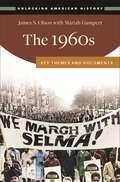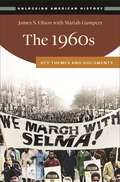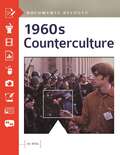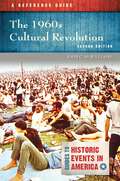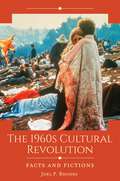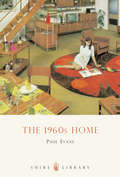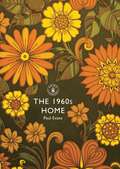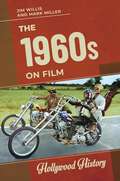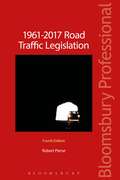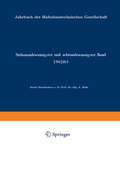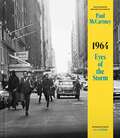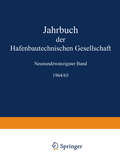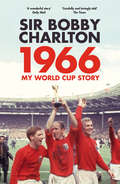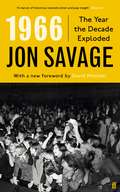- Table View
- List View
The 1960s: Key Themes and Documents (Unlocking American History)
by James S. Olson Mariah GumpertThis volume serves as an invaluable study guide covering all of the key political, social, and cultural concepts of the turbulent 1960s.The 1960s were a polarizing decade, beginning brightly and with hope but ending in disappointment and disarray. By the end, traditional values had been subverted, political institutions had been overturned, and marginalized groups had battled their own government to win equal rights and freedoms. The clear-cut foreign policies of the postwar era brought mixed results, and the world's mightiest nation became mired in a war it could not win. This overview of the 1960s covers all of the key political, social, and cultural concepts of the decade through topical and biographical entries, primary documents, a sample document-based essay question and top tips, and period-specific learning objectives. The book contains an Introduction that presents the historical themes of the period. Alphabetical encyclopedic entries relating to the period specific themes comprise the core reference material in the book. The book also contains a range of primary documents with their own introductions and a sample document-based essay question. Other features include a list of "Top Tips," a thematically tagged chronology, and a list of specific learning objectives readers can use to gauge their working knowledge and understanding of the period.
The 1960s: Key Themes and Documents (Unlocking American History)
by James S. Olson Mariah GumpertThis volume serves as an invaluable study guide covering all of the key political, social, and cultural concepts of the turbulent 1960s.The 1960s were a polarizing decade, beginning brightly and with hope but ending in disappointment and disarray. By the end, traditional values had been subverted, political institutions had been overturned, and marginalized groups had battled their own government to win equal rights and freedoms. The clear-cut foreign policies of the postwar era brought mixed results, and the world's mightiest nation became mired in a war it could not win. This overview of the 1960s covers all of the key political, social, and cultural concepts of the decade through topical and biographical entries, primary documents, a sample document-based essay question and top tips, and period-specific learning objectives. The book contains an Introduction that presents the historical themes of the period. Alphabetical encyclopedic entries relating to the period specific themes comprise the core reference material in the book. The book also contains a range of primary documents with their own introductions and a sample document-based essay question. Other features include a list of "Top Tips," a thematically tagged chronology, and a list of specific learning objectives readers can use to gauge their working knowledge and understanding of the period.
A 1960s Childhood: From Thunderbirds to Beatlemania (History Press Ser.)
by Paul FeeneyDo you remember Beatlemania? Radio Caroline? Mods and Rockers? The very first miniskirts? Then the chances are you were born in the or around 1960. To the young people of today, the 1960s seems like another age. But for those who grew up in this decade, school life, 'mod' fashions and sixties pop music are still fresh in their minds. From James Bond to Sindy dolls and playing hopscotch in the street, life was very different to how it is now. After the tough and frugal years of the fifties, the sixties was a boom period, a time of changed attitudes and improved lifestyles. With chapters on home and school life, games and hobbies, music and fashion, alongside a selection of charming illustrations, this delightful compendium of memories will appeal to all who grew up in this lively era. Take a nostalgic look at what it was like to grow up during the sixties and recapture all aspects of life back then. PAUL FEENEY is a writer and part-time business consultant. He has also written a local history of Highgate and A 1950s Childhood: from Tin Baths to Bread and Dripping. He lives in Surrey. "If you grew up in the Swinging Sixties, you’ll love Paul Feeney’s A 1960s Childhood." - Reviewed in Yours Magazine, 23rd Feb ’10. "The author captures the atmosphere and 'furniture' of the Sixties to perfection, even recreating a typical family Christmas of the time. Whether you were a child or an adult in that most eventful decade, this excellent book, with charming black and white illustrations, will throw up lots of talking points." - Reviewed in This England, Summer 2010 edition
1960s Counterculture: Documents Decoded (Documents Decoded)
by Jim WillisAn era that changed America forever is analyzed through the words of those who led, participated in, and opposed the protest movements that made the 1960s a signature epoch in U.S. culture.There is no better way to understand the 1960s than to read key speeches and texts from the decade, experiencing firsthand writings that capture a signature sense of passion and conviction. That is exactly the approach taken by this book as it analyzes major protest movements of the era, including the Vietnam War protests, the Civil Rights Movement, Women's Lib, the hippie movement, and the nascent GLBQT movement. Organized by movement, the work presents speeches, testimonies, and other important documents side-by-side with accessibly written, expert commentary. The documents and the themes they represent are linked to each other and to events during the decade to put the passionate thinking of the time in context and demonstrate its importance and legacy. By allowing readers to explore the 1960s in this visceral way, the book will provide an engaging learning experience for secondary school and university students, who will also gain helpful insights on how to evaluate historical documents. For the same reason, the volume will be a welcome resource for the general reader interested in understanding—or recalling—why the 1960s produced so many lasting changes in the American psyche.
1960s Counterculture: Documents Decoded (Documents Decoded)
by Jim WillisAn era that changed America forever is analyzed through the words of those who led, participated in, and opposed the protest movements that made the 1960s a signature epoch in U.S. culture.There is no better way to understand the 1960s than to read key speeches and texts from the decade, experiencing firsthand writings that capture a signature sense of passion and conviction. That is exactly the approach taken by this book as it analyzes major protest movements of the era, including the Vietnam War protests, the Civil Rights Movement, Women's Lib, the hippie movement, and the nascent GLBQT movement. Organized by movement, the work presents speeches, testimonies, and other important documents side-by-side with accessibly written, expert commentary. The documents and the themes they represent are linked to each other and to events during the decade to put the passionate thinking of the time in context and demonstrate its importance and legacy. By allowing readers to explore the 1960s in this visceral way, the book will provide an engaging learning experience for secondary school and university students, who will also gain helpful insights on how to evaluate historical documents. For the same reason, the volume will be a welcome resource for the general reader interested in understanding—or recalling—why the 1960s produced so many lasting changes in the American psyche.
The 1960s Cultural Revolution: A Reference Guide (Guides to Historic Events in America)
by John C. McWilliamsThe 1960s Cultural Revolution is a highly readable and valuable resource revisiting personalities and events that sparked the cultural revolutions that have become synonymous with the 1960s.The 1960s Cultural Revolution: A Reference Guide is an engagingly written book that considers the forces that shaped the 1960s and made it the unique era that it was. An introductory historical overview provides context and puts the decade in perspective. With a focus on social and cultural history, subsequent chapters focus on the New Left, the antiwar movement, the counterculture, and 1968, a year that stands alone in American history.The book also includes a wealth of reference material, a comprehensive timeline of events, biographical profiles of key players, primary documents that enhance the significance of the social, political, and cultural climate, a glossary of key terms, and a carefully selected annotated bibliography of print and nonprint sources for further study.
The 1960s Cultural Revolution: A Reference Guide (Guides to Historic Events in America)
by John C. McWilliamsThe 1960s Cultural Revolution is a highly readable and valuable resource revisiting personalities and events that sparked the cultural revolutions that have become synonymous with the 1960s.The 1960s Cultural Revolution: A Reference Guide is an engagingly written book that considers the forces that shaped the 1960s and made it the unique era that it was. An introductory historical overview provides context and puts the decade in perspective. With a focus on social and cultural history, subsequent chapters focus on the New Left, the antiwar movement, the counterculture, and 1968, a year that stands alone in American history.The book also includes a wealth of reference material, a comprehensive timeline of events, biographical profiles of key players, primary documents that enhance the significance of the social, political, and cultural climate, a glossary of key terms, and a carefully selected annotated bibliography of print and nonprint sources for further study.
The 1960s Cultural Revolution: Facts and Fictions (Historical Facts and Fictions)
by Joel P. RhodesThis book uses evidence-based primary source analysis to provide students with the historical perspective necessary to think critically about the romantic memories, stubborn stereotypes, misperceptions, deliberate falsehoods, distorted myths, and old grudges that distort our popular perceptions of the 1960s.Twenty-first century Americans routinely use the 1960s as a metaphor, a sort of convenient shorthand, for the cultural wars—that continuous clash over differing values, beliefs, attitudes, and lifestyles—still bitterly polarizing the nation. Therefore, understanding the 1960s cultural revolution is critical to understanding ourselves. What this book contributes to that conversation is needed historical perspective with evidence-based primary source analysis.Ten chapters shed light on ordinarily overlooked aspects of the period, challenge stubborn misconceptions, and explore the enduring legacy of the 1960s. Primary source material—both written and visual—is drawn from archival holdings, newspapers, published proceedings, oral histories, and memoirs in order to present a balanced, accessible examination of mistaken beliefs and the historical truths.
A 1960s East End Childhood
by Simon WebbDo you remember playing in streets free of traffic? Dancing to the Beatles? Watching a man land on the Moon on TV? Waking up to ice on the inside of the windows? If the answer is yes, then the chances are that you were a child in the 1960s. This delightful compendium of memories will appeal to all who grew up in the East End during the Swinging Sixties. With chapters on games and hobbies, school and holidays, this wonderful volume is sure to jog memories for all who remember this exciting decade.
The 1960s Home (Shire Library #604)
by Paul EvansThe 1960s witnessed a sustained period of economic growth, consumer spending and stable employment. This hitherto unknown prosperity enabled a market growth in levels of owner occupation and a subsequent boom in the sale of household furnishings and luxury goods. The 1960s Home looks at the styles and fashions in domestic housing and interiors between 1960 and 1970. Although this period has received increasing attention in recent years, much of it has been concentrated on progressive and exclusive design rather than on the furniture and furnishing of the 'average' home.
The 1960s Home (Shire Library #604)
by Paul EvansThe 1960s witnessed a sustained period of economic growth, consumer spending and stable employment. This hitherto unknown prosperity enabled a market growth in levels of owner occupation and a subsequent boom in the sale of household furnishings and luxury goods. The 1960s Home looks at the styles and fashions in domestic housing and interiors between 1960 and 1970. Although this period has received increasing attention in recent years, much of it has been concentrated on progressive and exclusive design rather than on the furniture and furnishing of the 'average' home.
The 1960s on Film (Hollywood History)
by Jim Willis Mark MillerThe 1960s on Film tells the narrative of the 1960s through the lens of the movie camera, analyzing 10 films that focus on the people, events, and issues of the decade.Films create both an impression of and — at times for younger audiences — a primary definition of events, people, and issues of an era. The 1960s on Film examines the 1960s as the decade was presented in ten films that focused on that decade. Discussion will focus on both what the films have to say about the era and how close they come to accurately depicting it.For example, films such as Mississippi Burning and Selma tell the story of racial conflict and hope for reconciliation in the 1960s. Other films such as The Right Stuff and Hidden Figures show the deep fascination America had at that time with the burgeoning space program and NASA, while Easy Rider analyzes the role of rock music and drugs among young people of the decade. The Deer Hunter studies the controversies surrounding the war in Vietnam. The Graduate, Mad Men, JFK, and Thirteen Days also receive significant treatment in this exciting volume.
The 1960s on Film (Hollywood History)
by Jim Willis Mark MillerThe 1960s on Film tells the narrative of the 1960s through the lens of the movie camera, analyzing 10 films that focus on the people, events, and issues of the decade.Films create both an impression of and — at times for younger audiences — a primary definition of events, people, and issues of an era. The 1960s on Film examines the 1960s as the decade was presented in ten films that focused on that decade. Discussion will focus on both what the films have to say about the era and how close they come to accurately depicting it.For example, films such as Mississippi Burning and Selma tell the story of racial conflict and hope for reconciliation in the 1960s. Other films such as The Right Stuff and Hidden Figures show the deep fascination America had at that time with the burgeoning space program and NASA, while Easy Rider analyzes the role of rock music and drugs among young people of the decade. The Deer Hunter studies the controversies surrounding the war in Vietnam. The Graduate, Mad Men, JFK, and Thirteen Days also receive significant treatment in this exciting volume.
1961-2017 Road Traffic Legislation: Annotated Legislation
by Robert Pierse1961-2017 Road Traffic Legislation sets out annotated road traffic legislation from 1961 to 2017 and covers all relevant case law and Statutory Instruments. Includes reference to litigation on intoxicants, dangerous driving and other areas of Road Traffic Law. This title covers both practice and procedure and each section is annotated fully and cross referenced.Road traffic law is a vital part of many smaller solicitors' firms' daily work and this title provides them with annotated legislation in an area rife with difficulty as the legislation is piecemeal and often contradictory. Many Statutory Instruments and Acts are created in this area: some enacted in full, others not. This book updates the practitioner on this thorny area of law and points them to relevant case law where necessary.
1963 That Was the Year That Was: That Was The Year That Was
by Andrew CookA compendium of milestone stories and watershed events in popular culture, national and international politics from 1963, including: The Beatles' first No 1, the coldest winter since 1740, Martin Luther King's 'I Have a Dream' speech, the Great Train Robbery, the Profumo Affair, Ian Brady and Myra Hindley's killings, the first woman in Space, Valentina Tereshkova, James Bond becomes an international phenomenon, 70,000 protest against nuclear weapons in London, Harold Wilson's election, and the onset of 'new politics' and satire, the assassination of JFK, the BBC launch of Doctor Who.
1964: Eyes Of The Storm
by Paul McCartneyPhotographs and Reflections by Paul McCartney'Millions of eyes were suddenly upon us, creating a picture I will never forget for the rest of my life.'In 2020, an extraordinary trove of nearly a thousand photographs taken by Paul McCartney on a 35mm camera was re-discovered in his archive. They intimately record the months towards the end of 1963 and beginning of 1964 when Beatlemania erupted in the UK and, after the band's first visit to the USA, they became the most famous people on the planet. The photographs are McCartney's personal record of this explosive time, when he was, as he puts it, in the 'Eyes of the Storm'.1964: Eyes of the Storm presents 275 of McCartney's photographs from the six cities of these intense, legendary months - Liverpool, London, Paris, New York, Washington, D.C. and Miami - and many never-before-seen portraits of John, George and Ringo. In his Foreword and Introductions to these city portfolios, McCartney remembers 'what else can you call it - pandemonium' and conveys his impressions of Britain and America in 1964 - the moment when the culture changed and the Sixties really began.1964: Eyes of the Storm includes:- Six city portfolios - Liverpool, London, Paris, New York, Washington, D.C. and Miami - and a Coda on the later months of 1964 - featuring 275 of Paul McCartney's photographs and his candid reflections on them- A Foreword by Paul McCartney- Beatleland, an Introduction by Harvard historian and New Yorker essayist Jill Lepore- A Preface by Nicholas Cullinan, Director of the National Portrait Gallery, London, and Another Lens, an essay by Senior Curator Rosie Broadley
1964 - 2004: Aufbruch, Aufstieg und neue Ungewissheit
by Werner LindnerVierzig Jahre nach dem programmatischen Sammelwerk "Was ist Jugendarbeit?" treffen damalige Initiatoren der Kinder- und Jugendarbeit auf jene, die sich gegenwärtig um neue Konzepte des sich verändernden Handlungsfelds bemühen. Vor dem Hintergrund der Theorieansätze von 1964 wird erneut untersucht, welche Orientierungen für professionelle, theoretische und gesellschaftspolitische Verortung der Kinder- und Jugendarbeit künftig bestehen.
1964, A Year in African American Performance History (ISSN)
by David KrasnerThis book examines the Civil Rights Movement from the perspective of a single year, 1964.The book analyses specific events that occurred in 1964 as benchmarks of the Civil Right Movement, making the case that 1964 was a watershed year. Each chapter considers individually politics, rhetoric, sports, dramatic literature, film, art, and music, breaking down the events and illustrating their importance to the social and political life in the United States in 1964. This study emphasizes 1964 as a nodal point in the history of the Civil Rights Movement, arguing that it was within this single year that the tide against racism and injustice turned markedly.This book will be of great interest to the scholars and students of civil rights, theatre and performance, art history, and drama literature.
1964, A Year in African American Performance History (ISSN)
by David KrasnerThis book examines the Civil Rights Movement from the perspective of a single year, 1964.The book analyses specific events that occurred in 1964 as benchmarks of the Civil Right Movement, making the case that 1964 was a watershed year. Each chapter considers individually politics, rhetoric, sports, dramatic literature, film, art, and music, breaking down the events and illustrating their importance to the social and political life in the United States in 1964. This study emphasizes 1964 as a nodal point in the history of the Civil Rights Movement, arguing that it was within this single year that the tide against racism and injustice turned markedly.This book will be of great interest to the scholars and students of civil rights, theatre and performance, art history, and drama literature.
1965 Turning the Tide: How India Won The War
by Nitin A GokhaleFifty years in a nation's life is a small period of time. However, it is quite likely that collective memory will have faded about several events…and so it is with the 1965 war that India was dragged into by Pakistan's chronic insecurities and territorial ambitions. This time in the form of a forcible attempt to annex Kashmir. Today, the details of the war that came between the tragedy of 1962 and the triumph of 1971 are hazy in the memory of the country.But it is a story that needs to be retold. Caught by surprise at the Pakistani offensive, India, then struggling as a nation, responded with extraordinary zeal and turned the tide in a war Pakistan thought it would win because of its superior weapons and tactics. But as the outcome of the 1965 war tells us, Pakistan not only failed to achieve any of its strategic objectives but had to suffer a massive setback, thanks to a combination of resolute political leadership, the brave Indian soldiers and determined citizens. This then is the account of the war that India has largely forgotten. In this meticulously researched and fast paced book, journalist and national security analyst Nitin A. Gokhale, has produced a formidable and comprehensive evaluation of the events and aftermath of the ferocious Indo-Pak war of 1965.
1966: My World Cup Story
by Bobby CharltonFifty years on, the ultimate football and World Cup legend Sir Bobby Charlton looks back on England’s greatest sporting triumph Wembley, 1966. England wins the World Cup to roars of a euphoric home crowd.Sir Bobby Charlton, England’s greatest ever player, was there on the pitch. Now, half a century on, he looks back on the most glorious moment of his life and England's greatest sporting achievement. In 1966, he takes us through the build-up to the tournament and to the final itself - what he saw, what he heard, what he felt. He tells us what it was like to be part of Sir Alf Ramsey’s team, his memories of his teammates, the matches, the atmosphere; the emotion of being carried on the wave of a nation’s euphoria and how it felt to go toe-to-toe with some of the foremost footballers to ever play the game. His life has been forever defined by a single moment: one day when a man stood side-by-side with his best friends, united in a single aim in front of a watching nation. This is his story.‘It’s gripping stuff… This is a mellow book, the product of many years’ contemplation, and emotional in a way that may surprise you…He has a wonderful story to tell’ Daily Mail
1966: The Year the Decade Exploded
by Jon SavageThe pop world accelerated and broke through the sound barrier in 1966. In America, in London, in Amsterdam, in Paris, revolutionary ideas slow-cooking since the late '50s reached boiling point. In the worlds of pop, pop art, fashion and radical politics -- often fueled by perception-enhancing substances and literature -- the 'Sixties', as we have come to know them, hit their Modernist peak. A unique chemistry of ideas, substances, freedom of expression and dialogue across pop cultural continents created a landscape of immense and eventually shattering creativity. After 1966 nothing in the pop world would ever be the same. The 7 inch single outsold the long-player for the final time. It was the year in which the ever lasting and transient pop moment would burst forth in its most articulate, instinctive and radical way. Jon Savage's 1966 is a monument to the year that shaped the pop future of the balance of the century. Exploring canonical artists like The Beatles, The Byrds, Velvet Underground, The Who and The Kinks, 1966 also goes much deeper into the social and cultural heart of the decade through unique archival primary sources.
